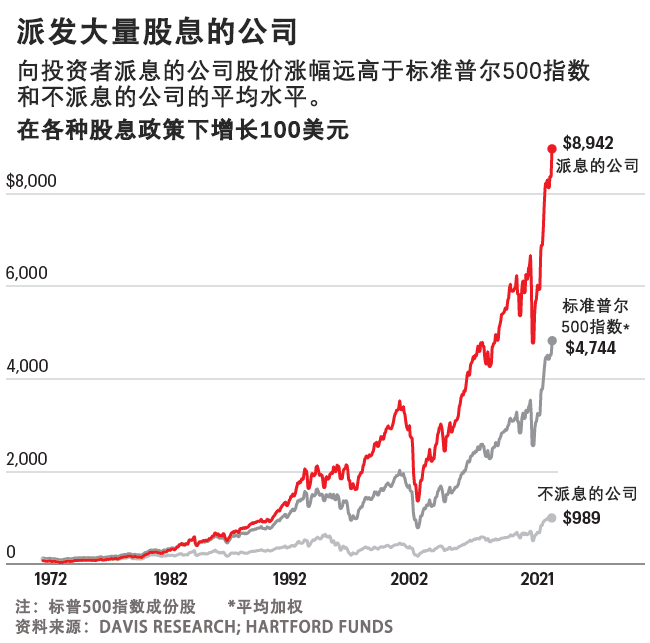
在為股東帶來收益的三大方式中——資本利得、回購和股息——長期來看,股息是最有力的貢獻者。Hartford Funds公司在最近的一項研究中發現,從1973年到2021年,按季度派息的公司每年錄得9.6%的年回報率,打破了不派息公司4.79%的紀錄,超過了整體市場8.2%的平均水平。自1930年以來,派息股貢獻了40%的股東總收益。然而,在過去15年里,隨著市盈率(P/E)的爆炸式增長(主要是由從不派息的科技巨頭股價飆升推動的),股息收益所占的比例下降了一半以上,降至15%左右。由于這種下跌趨勢,投資者幾乎忘記了歷史上表現最好的是派息公司。
如今,動蕩的環境對那些長跑冠軍非常有利。要了解原因,重要的是要分析一下典型的派息公司中堅力量的情況。這些都是成熟的、總體穩定的企業,對資本的投資需求并不大。它們的巔峰成長階段已經過去。它們收益的最佳用途是將現金轉給投資者。派息股的一個標志就是與整體市場相比,它們很便宜,現在的情況更是如此。它們提供相對于股價的高收益,這一方案使它們能夠支付巨額收益。Research Affiliates的首席執行官克里斯·布賴特曼說:“與增長相比,價值股從來沒有這么便宜過。”該公司負責監管1,680億美元共同基金和交易型開放式指數基金(ETF)的投資策略。布賴特曼預測,未來幾年,作為“價值”堡壘的派息公司將獲得重大利好。他表示:“未來五年或十年,價值股的估值將‘回歸均值’,這意味著它們將通過增長來縮小鴻溝,并在此過程中顯著跑贏大盤。”
我們鎖定了五只符合四個重要條件的股票:股息生息率至少為4.5%;市盈率約為16或更低,而標準普爾500指數(S&P 500)的市盈率約為20;歷史上收入穩定;股價下跌與其基本面不符。
黑石集團(Blackstone,股票代碼:BX)
股息生息率:5.57%
市盈率:16.8
價格從52周高點下跌:–37%
這家私募股權巨頭將其管理的9,410億美元資產分散在對公司、信貸和保險以及房地產的投資中。但其房地產部門的增長最為顯著,并且有望在未來繼續提供快速增長的現金流。2021年,黑石集團可分配給股東的78億美元收益中,有一半多一點來自其各類高回報房地產基金的費用和業績獎金。
在轉向遠程工作導致崩潰之前,黑石集團很有先見之明,退出了在美國的大部分辦公資產板塊,并且在很久以前就拋售了郊區的辦公室商場。公寓是該公司在房地產領域的四大“強勢主題”之一。其他三個領域的需求也應該保持強勁:為制作流媒體節目的電影制片廠提供空間、生命科學領域租戶占用的實驗室,以及在數字經濟中儲存待交付產品的倉庫。在最后一個類別中,黑石集團通常擁有最靠近人口密集地區的最好房產,而在這些地區很難獲得新許可。
房地產市場的低迷也將帶來逢低買入的機會。在過去20年里,一些最好的市盈率回報來自于2008年和2009年創立的基金,當時股價暴跌——黑石集團現在持有1,700億美元的“基金備用金”。

陶氏公司(Dow Inc.,股票代碼:DOW)
股息生息率:6.0%
市盈率:6.0
價格從52周高點下跌:–33%
陶氏公司是2019年初從老陶氏杜邦(DowDuPont)分拆出來的三家子公司中最大的一家。它生產包裝、塑料、工業涂料和建筑涂料等基礎產品。首席執行官吉姆·菲特林預計,從2022年到2025年,陶氏公司的終端市場將分別增長3.3%和5.5%,平均比新冠疫情前的增速快一個百分點。
然而,陶氏公司的股價正在跌破2019年年末的水平,市盈率只有區區6倍。在過去的四個季度中,該公司創造了66億美元的豐厚凈收入,派發的股息卻不到這一數字的三分之一,目前的收益率為6%。因此,陶氏公司在向股東返還資本方面有很大的回旋余地。該公司最近宣布了一項回購30億美元股票的計劃,并在第一季度根據該計劃回購了6億美元股票。24億美元的基金備用金占其當前估值的7%以上。
美國投資研究公司Alembic Global Advisors的分析師哈桑·艾哈邁德稱贊陶氏公司的成本管理非常出色。他說:“該公司將行政管理費用(即銷售、綜合和管理費用)與同行進行比較,以確保自己在每個類別中都是最高效的。該公司旨在派發高額股息和進行嚴格運營,而不是為了建立帝國或追求擴張計劃。”艾哈邁德補充道,他強烈推薦買入這只股票。“該公司遭受了整個市場動蕩的影響。但6%的股息是有保證的。該公司的收入如此強勁,即使在經濟衰退的情況下也不會削減。該公司的股票交易價格遠低于這樣一家公司的應有水平。”隨著道瓊斯指數(Dow Jones Index)的市盈率達到與盈利和增長相似的工業巨頭相當的水平,幾乎沒有什么選擇可以提供比這更好的機會,實現股息增長、大規模回購和巨額資本利得。
Enterprise Products Partners公司(股票代碼:EPD)
股息生息率:7.4%
市盈率:11.6
價格從52周高點下跌:–10%
Enterprise Products公司是所謂的“主要有限合伙”。主要有限合伙需要將大部分現金流轉給投資者。它們不在合伙企業層面納稅;相反,股東們要對特殊K-1申報中詳細列出的納稅負責。潛在投資者應該研究主要有限合伙的稅收待遇。但總的來說,股東的主要有限合伙分紅納稅額通常低于定期股息納稅額。
Enterprise Products Partners公司是熱門能源行業的一個相對安全的賭注,因為它的命運不依賴石油和天然氣的價格。它是一家“中游”企業,運營著長達5萬英里(約80,467.2千米)的管道網絡,將天然氣、液化天然氣、原油和石化產品從生產商輸送到煉油廠、公用事業單位和工廠。該公司具有極低的杠桿率,而且不論是艱難周期,還是平穩周期,都能夠產生高額資本回報。對乙烯(用于防凍劑、塑料和溶劑)和丙烯的需求也在不斷增長。該公司的聯席首席執行官蘭迪·福勒對《財富》雜志表示:“在過去十年里,乙烯需求的增長速度是GDP的1.2倍,丙烯需求的增長速度是GDP的1.5倍。”
持之以恒的成果是:連續24年股息增長。
亨廷頓銀行(Huntington Bancshares,股票代碼:HBAN)
股息生息率:4.5%
市盈率:12.0
價格從52周高點下跌:–24%
亨廷頓銀行是一家中型銀行,對尋求派息的人來說,它比巨頭們更有優勢:4.5%的股息生息率遠遠超過摩根大通(JPMorgan,3.4%)、美國銀行(BofA,2.6%)和富國銀行(Wells Fargo,2.7%)。亨廷頓銀行長期以來一直是密歇根州、俄亥俄州和賓夕法尼亞州西部的巨頭,提供三大主要業務:個人銀行業務、汽車貸款和中級市場信貸。去年6月,它通過以60億美元收購TCF Financial,將業務擴展到明尼阿波利斯、丹佛和芝加哥,擴展到在11個州擁有1,000家分支機構。
Stephens的分析師特里·麥克沃伊說:“亨廷頓銀行開創了一種低費用、客戶友好的零售銀行業務模式。它們擁有出色的客戶保留率。”利率上升應該會增加銀行的凈利息收入——但其收入增長和現金流已經很強勁了。過去四個季度,該公司創造了26億美元的自由現金流,幾乎是用于派息的現金流的三倍。自2017年年底以來,亨廷頓銀行的股息幾乎翻了一番,并在去年第四季度將股息提高了3%。亨廷頓銀行在最近的美聯儲壓力測試中表現良好,這表明它不僅可以維持如此高的股息,而且可能還會增加股息。
Janus Henderson公司(股票代碼:JHG)
股息生息率:6.69%
市盈率:7.9
價格從52周高點下跌:–52%
Janus Henderson公司是納爾遜·佩爾茨的Trian對沖基金試圖重振的兩家資產管理公司之一,另外一家是景順投資管理有限公司(Invesco)。這家英國集團是2017年兩家中型企業Janus Capital和Henderson Group合并的產物。但工會未能取得成功。自合并以來,Janus Henderson公司管理的資產基本持平在3,000億美元的范圍內。第二季度,Janus公司凈流出78億美元。
作為持有19%股份的股東,佩爾茨正在推動變革:去年年底,聯博基金(AllianceBernstein)的前首席財務官阿里·迪巴德吉出任首席執行官,今年2月,佩爾茨和合伙人埃德·加登加入了董事會。佩爾茨和加登還認為,資產管理領域的關鍵在于規模。因此,Janus公司能夠通過與規模相當的競爭對手合并或出售給行業巨頭而受益。作為牽線搭橋的人,佩爾茨在這一領域有著出色的業績。作為美盛集團(Legg Mason)的大投資者,他在2000年將美盛集團出售給富蘭克林鄧普頓投資公司(Franklin Templeton),在9個月內獲得了7,000萬美元的收益。
吸引力:雖然Janus公司的利潤自合并以來沒有增長,但利潤很穩定,而且相對于股息和被打壓的估值來說,利潤非常豐厚。過去四個季度,該公司凈利潤為5.02億美元。這是派發給股東的2.6億美元的近兩倍。任何大幅增加管理資產或降低成本的經營改善,都可能引發股息和股價的大幅上漲。和許多中型基金管理公司一樣,Janus公司是一個有吸引力的收購對象。(財富中文網)
本文登載于《財富》雜志2022年10/11月刊。
譯者:中慧言-王芳
在為股東帶來收益的三大方式中——資本利得、回購和股息——長期來看,股息是最有力的貢獻者。Hartford Funds公司在最近的一項研究中發現,從1973年到2021年,按季度派息的公司每年錄得9.6%的年回報率,打破了不派息公司4.79%的紀錄,超過了整體市場8.2%的平均水平。自1930年以來,派息股貢獻了40%的股東總收益。然而,在過去15年里,隨著市盈率(P/E)的爆炸式增長(主要是由從不派息的科技巨頭股價飆升推動的),股息收益所占的比例下降了一半以上,降至15%左右。由于這種下跌趨勢,投資者幾乎忘記了歷史上表現最好的是派息公司。
如今,動蕩的環境對那些長跑冠軍非常有利。要了解原因,重要的是要分析一下典型的派息公司中堅力量的情況。這些都是成熟的、總體穩定的企業,對資本的投資需求并不大。它們的巔峰成長階段已經過去。它們收益的最佳用途是將現金轉給投資者。派息股的一個標志就是與整體市場相比,它們很便宜,現在的情況更是如此。它們提供相對于股價的高收益,這一方案使它們能夠支付巨額收益。Research Affiliates的首席執行官克里斯·布賴特曼說:“與增長相比,價值股從來沒有這么便宜過。”該公司負責監管1,680億美元共同基金和交易型開放式指數基金(ETF)的投資策略。布賴特曼預測,未來幾年,作為“價值”堡壘的派息公司將獲得重大利好。他表示:“未來五年或十年,價值股的估值將‘回歸均值’,這意味著它們將通過增長來縮小鴻溝,并在此過程中顯著跑贏大盤。”
我們鎖定了五只符合四個重要條件的股票:股息生息率至少為4.5%;市盈率約為16或更低,而標準普爾500指數(S&P 500)的市盈率約為20;歷史上收入穩定;股價下跌與其基本面不符。
黑石集團(Blackstone,股票代碼:BX)
股息生息率:5.57%
市盈率:16.8
價格從52周高點下跌:–37%
這家私募股權巨頭將其管理的9,410億美元資產分散在對公司、信貸和保險以及房地產的投資中。但其房地產部門的增長最為顯著,并且有望在未來繼續提供快速增長的現金流。2021年,黑石集團可分配給股東的78億美元收益中,有一半多一點來自其各類高回報房地產基金的費用和業績獎金。
在轉向遠程工作導致崩潰之前,黑石集團很有先見之明,退出了在美國的大部分辦公資產板塊,并且在很久以前就拋售了郊區的辦公室商場。公寓是該公司在房地產領域的四大“強勢主題”之一。其他三個領域的需求也應該保持強勁:為制作流媒體節目的電影制片廠提供空間、生命科學領域租戶占用的實驗室,以及在數字經濟中儲存待交付產品的倉庫。在最后一個類別中,黑石集團通常擁有最靠近人口密集地區的最好房產,而在這些地區很難獲得新許可。
房地產市場的低迷也將帶來逢低買入的機會。在過去20年里,一些最好的市盈率回報來自于2008年和2009年創立的基金,當時股價暴跌——黑石集團現在持有1,700億美元的“基金備用金”。
陶氏公司(Dow Inc.,股票代碼:DOW)
股息生息率:6.0%
市盈率:6.0
價格從52周高點下跌:–33%
陶氏公司是2019年初從老陶氏杜邦(DowDuPont)分拆出來的三家子公司中最大的一家。它生產包裝、塑料、工業涂料和建筑涂料等基礎產品。首席執行官吉姆·菲特林預計,從2022年到2025年,陶氏公司的終端市場將分別增長3.3%和5.5%,平均比新冠疫情前的增速快一個百分點。
然而,陶氏公司的股價正在跌破2019年年末的水平,市盈率只有區區6倍。在過去的四個季度中,該公司創造了66億美元的豐厚凈收入,派發的股息卻不到這一數字的三分之一,目前的收益率為6%。因此,陶氏公司在向股東返還資本方面有很大的回旋余地。該公司最近宣布了一項回購30億美元股票的計劃,并在第一季度根據該計劃回購了6億美元股票。24億美元的基金備用金占其當前估值的7%以上。
美國投資研究公司Alembic Global Advisors的分析師哈桑·艾哈邁德稱贊陶氏公司的成本管理非常出色。他說:“該公司將行政管理費用(即銷售、綜合和管理費用)與同行進行比較,以確保自己在每個類別中都是最高效的。該公司旨在派發高額股息和進行嚴格運營,而不是為了建立帝國或追求擴張計劃。”艾哈邁德補充道,他強烈推薦買入這只股票。“該公司遭受了整個市場動蕩的影響。但6%的股息是有保證的。該公司的收入如此強勁,即使在經濟衰退的情況下也不會削減。該公司的股票交易價格遠低于這樣一家公司的應有水平。”隨著道瓊斯指數(Dow Jones Index)的市盈率達到與盈利和增長相似的工業巨頭相當的水平,幾乎沒有什么選擇可以提供比這更好的機會,實現股息增長、大規模回購和巨額資本利得。
Enterprise Products Partners公司(股票代碼:EPD)
股息生息率:7.4%
市盈率:11.6
價格從52周高點下跌:–10%
Enterprise Products公司是所謂的“主要有限合伙”。主要有限合伙需要將大部分現金流轉給投資者。它們不在合伙企業層面納稅;相反,股東們要對特殊K-1申報中詳細列出的納稅負責。潛在投資者應該研究主要有限合伙的稅收待遇。但總的來說,股東的主要有限合伙分紅納稅額通常低于定期股息納稅額。
Enterprise Products Partners公司是熱門能源行業的一個相對安全的賭注,因為它的命運不依賴石油和天然氣的價格。它是一家“中游”企業,運營著長達5萬英里(約80,467.2千米)的管道網絡,將天然氣、液化天然氣、原油和石化產品從生產商輸送到煉油廠、公用事業單位和工廠。該公司具有極低的杠桿率,而且不論是艱難周期,還是平穩周期,都能夠產生高額資本回報。對乙烯(用于防凍劑、塑料和溶劑)和丙烯的需求也在不斷增長。該公司的聯席首席執行官蘭迪·福勒對《財富》雜志表示:“在過去十年里,乙烯需求的增長速度是GDP的1.2倍,丙烯需求的增長速度是GDP的1.5倍。”
持之以恒的成果是:連續24年股息增長。
亨廷頓銀行(Huntington Bancshares,股票代碼:HBAN)
股息生息率:4.5%
市盈率:12.0
價格從52周高點下跌:–24%
亨廷頓銀行是一家中型銀行,對尋求派息的人來說,它比巨頭們更有優勢:4.5%的股息生息率遠遠超過摩根大通(JPMorgan,3.4%)、美國銀行(BofA,2.6%)和富國銀行(Wells Fargo,2.7%)。亨廷頓銀行長期以來一直是密歇根州、俄亥俄州和賓夕法尼亞州西部的巨頭,提供三大主要業務:個人銀行業務、汽車貸款和中級市場信貸。去年6月,它通過以60億美元收購TCF Financial,將業務擴展到明尼阿波利斯、丹佛和芝加哥,擴展到在11個州擁有1,000家分支機構。
Stephens的分析師特里·麥克沃伊說:“亨廷頓銀行開創了一種低費用、客戶友好的零售銀行業務模式。它們擁有出色的客戶保留率。”利率上升應該會增加銀行的凈利息收入——但其收入增長和現金流已經很強勁了。過去四個季度,該公司創造了26億美元的自由現金流,幾乎是用于派息的現金流的三倍。自2017年年底以來,亨廷頓銀行的股息幾乎翻了一番,并在去年第四季度將股息提高了3%。亨廷頓銀行在最近的美聯儲壓力測試中表現良好,這表明它不僅可以維持如此高的股息,而且可能還會增加股息。
Janus Henderson公司(股票代碼:JHG)
股息生息率:6.69%
市盈率:7.9
價格從52周高點下跌:–52%
Janus Henderson公司是納爾遜·佩爾茨的Trian對沖基金試圖重振的兩家資產管理公司之一,另外一家是景順投資管理有限公司(Invesco)。這家英國集團是2017年兩家中型企業Janus Capital和Henderson Group合并的產物。但工會未能取得成功。自合并以來,Janus Henderson公司管理的資產基本持平在3,000億美元的范圍內。第二季度,Janus公司凈流出78億美元。
作為持有19%股份的股東,佩爾茨正在推動變革:去年年底,聯博基金(AllianceBernstein)的前首席財務官阿里·迪巴德吉出任首席執行官,今年2月,佩爾茨和合伙人埃德·加登加入了董事會。佩爾茨和加登還認為,資產管理領域的關鍵在于規模。因此,Janus公司能夠通過與規模相當的競爭對手合并或出售給行業巨頭而受益。作為牽線搭橋的人,佩爾茨在這一領域有著出色的業績。作為美盛集團(Legg Mason)的大投資者,他在2000年將美盛集團出售給富蘭克林鄧普頓投資公司(Franklin Templeton),在9個月內獲得了7,000萬美元的收益。
吸引力:雖然Janus公司的利潤自合并以來沒有增長,但利潤很穩定,而且相對于股息和被打壓的估值來說,利潤非常豐厚。過去四個季度,該公司凈利潤為5.02億美元。這是派發給股東的2.6億美元的近兩倍。任何大幅增加管理資產或降低成本的經營改善,都可能引發股息和股價的大幅上漲。和許多中型基金管理公司一樣,Janus公司是一個有吸引力的收購對象。(財富中文網)
本文登載于《財富》雜志2022年10/11月刊。
譯者:中慧言-王芳
Of the three vehicles that deliver gains to shareholders—capital gains, buybacks, and dividends—dividends are the most powerful contributor over long periods. In a recent study, Hartford Funds found that from 1973 to 2021, companies that made those quarterly payments furnished annual returns of 9.6% a year, crushing non-payers’ record of 4.79% and beating the overall market average of 8.2%. Since 1930, dividend stocks have provided an outsize 40% of total shareholder gains. Yet in the past 15 years as price/earnings multiples (P/Es) exploded, driven primarily by the soaring prices of tech titans that frequently didn’t pay dividends at all, the share of gains attributable to dividends shrank by over half, to around 15%. As a result of that downtrend, investors pretty much forgot that over history, it’s the dividend payers that perform best.
Today’s tumultuous climate strongly favors those long-distance champions. To understand why, it’s important to analyze the profile of a typical dividend stalwart. These are mature, generally stable businesses that don’t have a big need for capital to invest. Their top growth stage is behind them. The best use of their earnings is channeling the cash to investors. A trademark of dividend stocks is that they’re cheap compared with the overall market, and never more so than today. They offer high earnings relative to their share prices, the formula that enables them to pay chunky yields. “Value has never been this cheap versus growth,” says Chris Brightman, CEO of Research Affiliates, a firm that oversees investment strategies for $168 billion in mutual funds and ETFs. Brightman foresees powerful tailwinds for the dividend payers that are the bulwarks of “value” in the years ahead. “Over five or 10 years, the valuations of value stocks will be ‘mean reverting,’ meaning that they’ll close the gulf with growth, and significantly outperform in the process,” he says.
We zeroed in on five stocks that hit four important boxes: a dividend yield of at least 4.5%; a P/E of around 16 or lower (versus around 20 for the S&P 500); a history of consistent earnings; and fourth, beaten-down stock prices not justified by their fundamentals.
Blackstone (BX)
Dividend yield: 5.57%
P/E: 16.8
Price drop from 52-week high: –37%
The private equity giant spreads its $941 billion in assets under management across investments in companies, credit and insurance, and real estate. But it’s the real estate arm that’s showing the most impressive growth, and that promises to keep delivering fast-increasing cash flows in the future. In 2021, Blackstone garnered just over half of the $7.8 billion in earnings available for distribution to shareholders from the fees and performance bonuses on its sundry, high-return property funds.
Blackstone presciently exited most of its office holdings in the U.S. before the meltdown driven by the shift to remote work, and long ago dumped suburban office malls. Apartments are one of its four “highest conviction themes” in real estate. The other three are also specialties in which demand should remain strong: space for film studios that produce programs for streaming; laboratories occupied by tenants in life sciences; and warehouses that store products for delivery in the digital economy. In this last category, Blackstone typically owns the best properties closest to big population centers, where it’s difficult to get new permits.
A real estate downturn will also bring opportunities for bargains. Some of the best P/E returns of the past 20 years flowed from funds that started in 2008 and 2009, when prices cratered—and Blackstone now holds $170 billion in “dry powder.”
Dow Inc. (DOW)
Dividend yield: 6.0%
P/E: 6.0
Price drop from 52-week high: –33%
Dow is the largest of the three units spun off from the old DowDuPont in early 2019. It makes such basic products as packaging, plastics, industrial coatings, and architectural paints. CEO Jim Fitterling predicts that Dow’s end markets will grow at 3.3% and 5.5% from 2022 to 2025, on average a point faster than the pre-COVID rate.
Yet Dow’s share price is languishing below late-2019 levels, resulting in a tiny multiple of six. In the past four quarters, it has generated sumptuous net income of $6.6 billion, and paid out just less than one-third of that figure to provide what’s now a yield of 6%. So Dow has plenty of latitude for returning capital to shareholders. It recently announced a plan to repurchase $3 billion in stock, and did $600 million in buybacks under the program in Q1. The $2.4 billion in dry powder represents over 7% of its current valuation.
Analyst Hassan Ahmed of Alembic Global Advisors praises Dow for excellent cost management. “They benchmark SG&A [selling, general, and administrative expenses] to their peers to ensure they’re among the most efficient in every category,” he says. “They’re all about paying a chunky dividend and tightly running operations, not about empire building or pursuing expansion plans.” The stock, he adds, is screaming buy. “They’ve suffered from the overall skittish market,” he says. “But the 6% dividend is guaranteed. Their earnings are so strong that it won’t be cut even in the event of a recession. It’s trading at multiples far below where a name like this should be trading.” Few choices offer a better opportunity for a blend of rising dividends, big buybacks, and large capital gains as Dow’s multiple rises to match the P/Es of industrial giants with similar earnings and growth.
Enterprise Products Partners (EPD)
Dividend yield: 7.4%
P/E: 11.6
Price drop from 52-week high: –10%
Enterprise Products is what’s called a “master limited partnership.” MLPs are required to channel a large share of their cash flow to investors. They don’t pay tax at the partnership level; instead, the shareholders are responsible for the levies detailed in special K-1 filings. Potential investors should study the tax treatment of MLPs. But in general, shareholders often pay lower taxes on MLP distributions than on regular dividends.
EPD is a relatively safe bet on the hot energy sector because its fortunes aren’t dependent on the price of oil and gas. It’s a “midstream” player that operates a network of pipelines covering 50,000 miles that transport natural gas, natural gas liquids, crude oil, and petrochemical products from producers to refineries, utilities, and plants. It features extremely low leverage, and generates high returns on capital through rough and smooth cycles. And there’s growing demand for ethylene (used in antifreeze, plastics, and solvents) and propylene. “Over the past 10 years, ethylene demand has grown at 1.2 times GDP, and propylene has increased at 1.5 times,” co-CEO Randy Fowler told Fortune.
The fruits of that consistency: 24 straight years of increasing dividends.
Huntington Bancshares (HBAN)
Dividend yield: 4.5%
P/E: 12.0
Price drop from 52-week high: –24%
Huntington is a midsize bank that for dividend seekers enjoys an advantage over the Goliaths: Its 4.5% dividend yield far exceeds those of JPMorgan (3.4%), BofA (2.6%), and Wells Fargo (2.7%). Huntington has long been a powerhouse in Michigan, Ohio, and Western Pennsylvania, offering three main lines: consumer banking, auto lending, and middle market credit. Last June, it expanded into Minneapolis, Denver, and Chicago via the $6 billion acquisition of TCF Financial, growing its network to 1,000 branches across 11 states.
“Huntington pioneered a low-fee, customer-friendly model for retail banking,” says Terry McEvoy, an analyst at Stephens. “They have excellent customer retention.” Rising rates should swell the bank’s net interest income—but its revenue growth and cash flows are already robust. Over the past four quarters, it’s churned $2.6 billion in free cash flow, almost three times the dollars flowing to dividends. Huntington has almost doubled its dividend since late 2017, and raised the payout 3% in Q4 of last year. Huntington fared well in the recent Fed stress tests, suggesting it can not only maintain that big dividend, but probably also grow it.
Janus Henderson (JHG)
Dividend yield: 6.69%
P/E: 7.9
Price drop from 52-week high: –52%
Janus Henderson is one of two asset managers (along with Invesco) that Nelson Peltz’s Trian hedge fund is attempting to revive. The British group is the product of the 2017 merger of two midsize players, Janus Capital and Henderson Group. But the union failed to pay off. Since the merger, Janus Henderson’s assets under management have pretty much flatlined in the $300 billion range. In Q2, Janus suffered $7.8 billion in net outflows.
As a 19% stakeholder, Peltz is pushing for change: Late last year, a new CEO, Ali Dibadj, former CFO of ?AllianceBernstein, took charge, and in February, Peltz and partner Ed Garden joined the board. Peltz and Garden also believe that the asset management space is all about scale. Hence Janus could benefit either from uniting with a like-size rival or selling to an industry giant. Peltz has a strong record as a matchmaker in the field. As a big investor in Legg Mason, he orchestrated its sale to Franklin Templeton in 2000, reaping a $70 million gain in nine months.
The attraction: Though Janus’s profits haven’t grown since the merger, they’re stable—and extremely large relative to both the dividend and beaten-down valuation. In the past four quarters, it’s posted net profits of $502 million. That’s nearly twice the $260 million it paid to shareholders. Any improvement in operations that substantially raises assets under management or lowers costs could ignite a big rise in both dividends and the stock price. And like many midsize money managers, Janus is an appealing takeover candidate?
This article appears in the October/November 2022 issue of Fortune.






